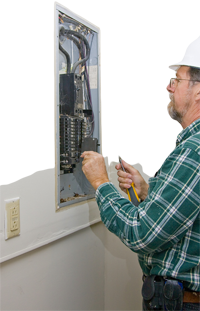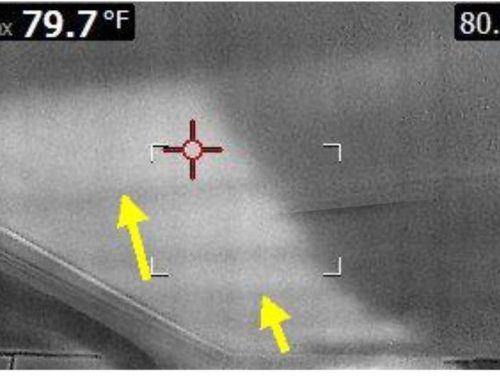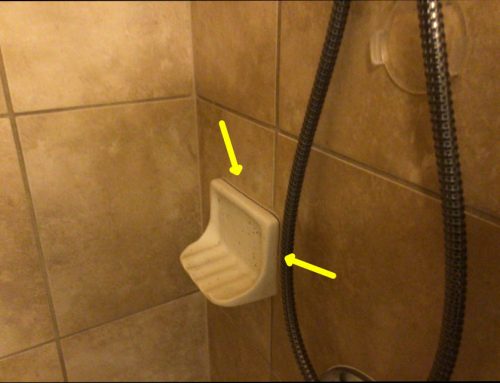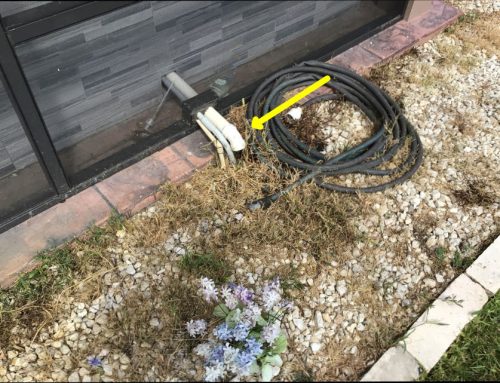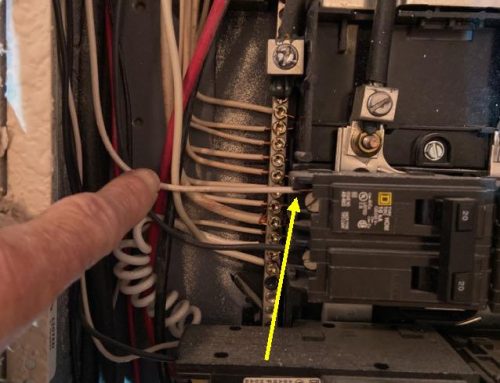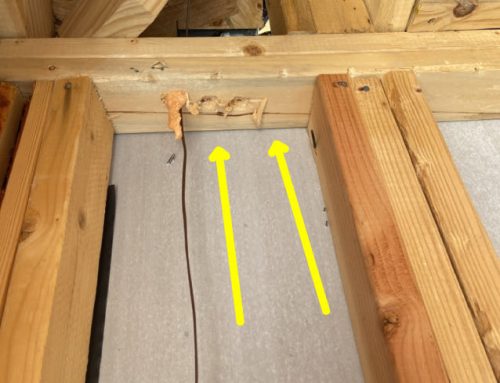Aluminum Wiring
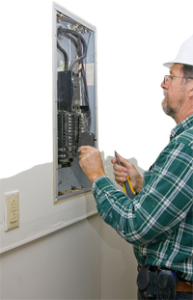
More On That
The choice of conductor material is a compromise among electrical properties, mechanical properties, and price. From the start, copper has been the material of choice for household branch circuits. Aluminum is softer than copper and weaker, and a poorer electrical conductor, so is not widely used in small sizes for home wiring.
In the mid-1960’s when the price of copper climbed for the sky, aluminum became more attractive economically. An aluminum version of type NM non-metallic sheathed cable (the common house wiring cable) became available, and was widely used through the 1960’s and until around 1972. It was gradually recognized that certain properties of aluminum were causing problems with connections, and occasional electrical fires resulted from overheating of those connections.
Observation and testing revealed the causes gradually. The layer of “tarnish”, or copper oxide, on the surface of a copper wire is a fairly good conductor, though not as good as the copper itself. It is also fairly soft, so tightening a brass terminal screw on a tarnished copper wire displaces the copper oxide layer, allowing a metal-to-metal contact between the wire and the terminal. However, the layer of aluminum oxide which forms within minutes on any exposed aluminum surface is a very poor conductor. Moreover, it adheres tightly to the underlying metal, so it is not displaced by tightening the connection, but remains between the wire and the terminal. Additionally, when copper and aluminum are pressed together, the joint is susceptible to accelerated corrosion, especially when subjected to dampness, heat and electric current.
Aluminum is relatively soft, and as temperature increases, expands more than the metals from which connectors are made. When current flows through a connection, the connection becomes warmer. The expansion of the aluminum, confined under a screw terminal, generates tremendous pressure, so that the metal “flows” into the empty spaces in the connector. When the electrical load is removed, the aluminum cools and contracts, and a gap forms between the wire and the connector. The slightly loose-fitting connection now has a higher resistance, and more corrosion forms in the gap, further increasing the resistance. The next time a heavy load is applied, the connection becomes even hotter, and so on, until one day the connection may burn out, or surrounding material may ignite.
Techniques and materials were gradually found to help alleviate the problem. Tightly-adhering corrosion inhibitors were invented to exclude oxygen from the wire surface, preventing corrosion. Better alloys for both the wire and the connectors reduced the corrosion and the mechanical stress. It was recognized that aluminum wire must be scraped or sanded to remove the oxide layer immediately before making a connection. Connectors were developed to prevent direct contact between aluminum and copper.
Meanwhile, large numbers of homes were built with aluminum wiring. These homes are now thirty to forty years old, and the presence of aluminum wiring, if it has not been upgraded, could be cause for concern.
When Was The House Built?
The home stands the greatest chance of having been built with aluminum wiring if it was built between 1965 and 1972. Aluminum wiring was seldom used for branch circuits before or after this period.
The Cable Jacket May Be Labeled “Aluminum”
It is usually possible to gain access to at least part of the home wiring in the attic, basement, crawl space, or unfinished garage. Aluminum cable will be identified with “AL” or the word “aluminum” printed or embossed on the cable jacket. Copper wire cable will not necessarily be identified as such. Remember, you are investigating branch circuits, and not the feeder bringing main power into the house. Finding the aluminum identification on the cable jacket is confirmation that aluminum wiring exists, but if you fail to find it, don’t assume there is no aluminum wiring. Keep in mind, also, that modifications may have been made, and additional wiring is likely to be copper, not aluminum.
What Aluminum Wire Looks Like
The remainder of this discussion involves disassembly, or at least opening, of electrical equipment. I believe that most homeowners should refer this to an electrician, and I will not attempt to provide do-it-yourself instructions. If you really can do this yourself, you don’t need my instruction, anyhow. If you have any doubts, leave it alone and call an electrician. You can create problems, or make existing conditions worse by disturbing aluminum wiring.
The easiest place to find bare wire ends is the circuit breaker panel. Aluminum wire, exposed to air and left undisturbed, will gradually change from shiny white to varying shades of gray, to almost black. Scratching the surface will reveal the bright white metal.
It is possible to be mislead by plating on the wire. Copper conductors were once commonly tin-plated, giving the conductors an appearance very similar to that of aluminum. Additionally, aluminum wire was occasionally copper-plated, and looks just like copper wire. Inspect the cut end of the wire to determine what is beneath a plating.
I Have It! Do I Have A Problem?
One can lead a perfectly normal life in a home with aluminum wiring. If there are no problems, one may be able to avoid upgrading for quite a while longer. Because the problems associated with aluminum wiring continue to develop indefinitely, the question is, in my opinion, not whether to upgrade, but how urgently the upgrade is needed. Here are some methods you can use to help you make the decision.
Warning Signs
The trouble with aluminum wiring is caused by bad connections, and the symptoms are the same as for bad connections in copper wiring. Observing any of these symptoms may indicate that the wiring needs attention, but will not, by itself, identify aluminum wiring. On the other hand, if you do have aluminum wiring, these signs will tell you that it is time for prompt action.
Incandescent lights may momentarily dim when a motor starts. Light dimming is often associated with starting-up of the refrigerator, freezer, air conditioner, or furnace blower. This symptom is difficult to interpret accurately. The problem may be caused by voltage drop in the wiring, rather than by bad connections. It is normal in many homes, particularly older homes built with a smaller electrical service. If the affected lights are on the same circuit as the motor (most large appliances have a dedicated circuit), the brief dimming is to be expected. If lights on a different circuit are also affected, the dimming indicates that the voltage drop is on the feeder to the loadcenter, or at a poor connection on the feeder. If the dimming lasts more than a second or two, or is accompanied by “flickering”, it could be caused by a loose connection that requires immediate attention.
Incandescent lights may momentarily brighten when a motor starts. This is a more serious symptom. It often indicates a poor connection in the neutral wire. This is serious because an open neutral will result in uneven dividing of the 240-volt line, so that half of the 120-volt circuits in the home will have too little voltage, and half will have too much – possibly as much as 240 volts. This condition should be investigated and repaired promptly.
Recurring flickering of incandescent lights often indicates a bad connection. If flickering affects more than one light at the same instant, it probably indicates a bad connection in the circuit supplying them. If it affects a single light, and other lights on the same circuit are not affected, the bad connection is probably in or at the light fixture. If wiggling the plug at the receptacle changes the symptoms, the receptacle is worn out and should be replaced.
Things suddenly stop working, and no circuit breakers have tripped. If a light, receptacle, or appliance suddenly ceases to operate, and no circuit breakers have tripped (or fuses blown), it may be caused by a connection that has burned out. Try the appliance somewhere else, if possible, or plug something else that works into the same receptacle. Change the lamp in a built-in light fixture. If the problem is with a hair dryer, try plugging in a lamp, instead. If these efforts show that the problem is in the wiring, it may be dangerous. On rare occasions, the circuit will begin to operate again after the connection has had time to cool. That does not mean the problem has gone away, but that the connection was overheated, has cooled, and will overheat again if the load is re-connected. Have this problem repaired immediately. Meanwhile, identify and turn off the circuit breaker (or remove the fuse) for that circuit.
Sparks, flame, smoke
Occasionally, a connection burns out in a receptacle or switch box. The fireworks can vary from disappointing to spectacular. There will be varying amounts of sparks, smoke, sometimes a brief flame, and a small amount of sound. Rarely, the event will set fire to surrounding material. When this event is observed by the home’s occupants, it usually inspires immediate action of one kind or another. The first thing to do is to turn off the circuit breaker to that circuit (or the main breaker). Observe the outlet or switch for at least half an hour to make sure there is no more smoke or flame. If there is, call the fire brigade (in most places in the US, dial 911). You can remove the face plate to better check for smoke and flame, but don’t stick your fingers or tools inside unless you know how to verify that the power is off. If fire persists, use a CO2-type or dry-chemical-type fire extinguisher. Do not use water. Have this fixed immediately.
Signs of overheating
More often, the burn-out happens unobserved. Look for signs of soot or scorching around or behind the face plate. Soot deposited at the connection slots of a receptacle is usually caused by a worn-out receptacle rather than by bad connections.
An overheated connection, especially at receptacle or switch terminals can cause the metal face plate screws to become very hot – even too hot to touch. The face plate itself will also be warm. A slight warming of the receptacle and plug is normal with a heavy load like a hair dryer or portable heater. No parts should ever become too hot to touch.
Have It Inspected
The surest way to determine whether or not there is a problem is to have an electrician go over the system thoroughly. The electrician will check the markings of outlets and switches (they should be marked CO/ALR), the tightness of connections at the breaker panel or fuse box, the condition of splices, signs of overheating, and so on. The homeowner can do these things, also, but the electrician will bring experience and may spot things an amateur might not.
Have It Load Tested
Consider having the electrician load test all circuits and all outlets. The test comprises applying full load for which the circuit and noting how much change occurs in the voltage. The test can determine if the wiring is adequate, whether there is a bad connection in the circuit, and can even help locate the problem. Checking outlet circuits is easy; checking lighting and appliance circuits requires more work. Load testing is the most accurate means of finding bad connections. It is also the most reliable way to verify that there is not an immediate problem.


